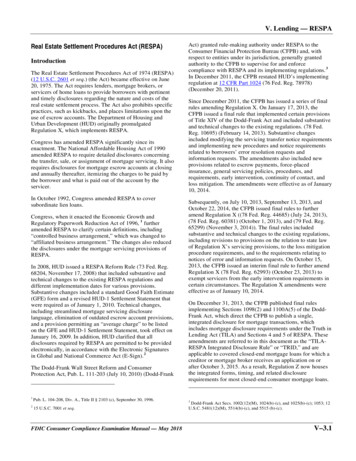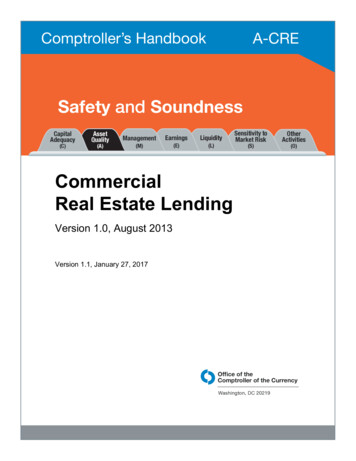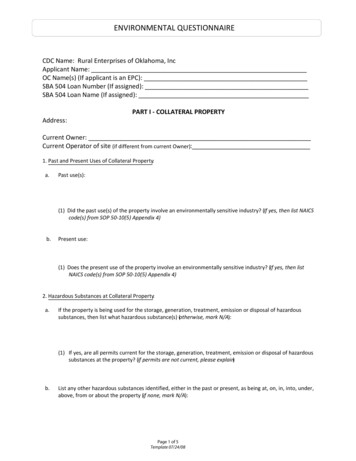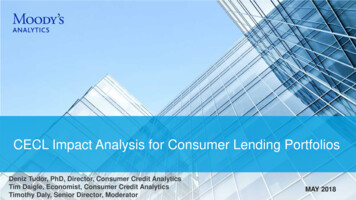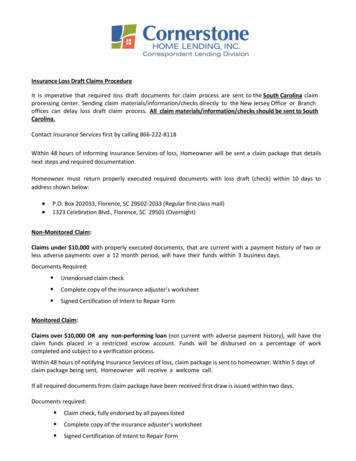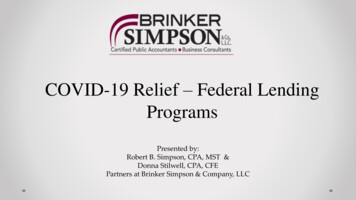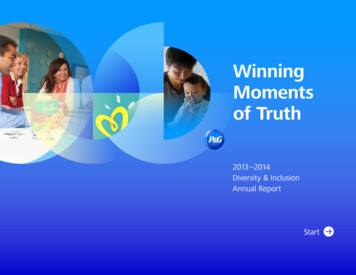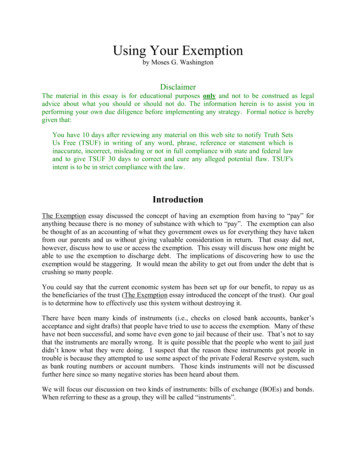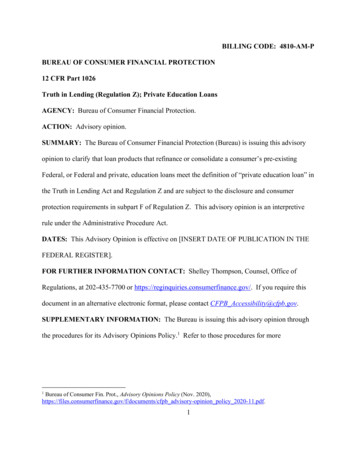
Transcription
BILLING CODE: 4810-AM-PBUREAU OF CONSUMER FINANCIAL PROTECTION12 CFR Part 1026Truth in Lending (Regulation Z); Private Education LoansAGENCY: Bureau of Consumer Financial Protection.ACTION: Advisory opinion.SUMMARY: The Bureau of Consumer Financial Protection (Bureau) is issuing this advisoryopinion to clarify that loan products that refinance or consolidate a consumer’s pre-existingFederal, or Federal and private, education loans meet the definition of “private education loan” inthe Truth in Lending Act and Regulation Z and are subject to the disclosure and consumerprotection requirements in subpart F of Regulation Z. This advisory opinion is an interpretiverule under the Administrative Procedure Act.DATES: This Advisory Opinion is effective on [INSERT DATE OF PUBLICATION IN THEFEDERAL REGISTER].FOR FURTHER INFORMATION CONTACT: Shelley Thompson, Counsel, Office ofRegulations, at 202-435-7700 or https://reginquiries.consumerfinance.gov/. If you require thisdocument in an alternative electronic format, please contact CFPB Accessibility@cfpb.gov.SUPPLEMENTARY INFORMATION: The Bureau is issuing this advisory opinion throughthe procedures for its Advisory Opinions Policy.1 Refer to those procedures for more1Bureau of Consumer Fin. Prot., Advisory Opinions Policy (Nov. s/cfpb advisory-opinion policy 2020-11.pdf.1
information.I. Advisory OpinionA. Background1. Growth of the postsecondary education loan marketThe postsecondary education loan market has swelled in the past decade and educationdebt has become an increasingly large share of total household debt, from 5 percent in 2008 to11 percent in 2020.2 Education loans issued or guaranteed by the Federal government, throughtitle IV of the Higher Education Act of 1965,3 which are administered by the U.S. Department ofEducation,4 currently comprise over 92 percent of the education loan market.5 Between 2006and 2012, the share of non-Federal education loans issued by private lenders ranged from2According to data compiled by the Federal Reserve Bank of New York (FRBNY), the nation’s educationindebtedness now ranks as the second largest source of consumer credit at the end of June 2020. Fed. Reserve Bankof New York Consumer Credit Panel/Equifax, Total Debt Balance and its ics/data.html (last visited Oct. 30, 2020).3Pub. L. 89-392, tit. IV, 79 stat. 1219, 1232 (1965).4The Direct Loan program was created by the Higher Education Amendments of 1992, Pub. L.102-325, 106 Stat.448 (1992), as a pilot program and expanded by the Student Loan Reform Act of 1993, Pub. L.103-66, tit. IV, subtit.A, 107 stat. 341 (1993). It was authorized by Omnibus Budget Reconciliation Act of 1993, Pub. L. 103-66, 107stat. 312 (1993) and amended by the Health Care and Education Reconciliation Act of 2010, Pub. L.111-152, 124stat. 1029 (2010). Under this program, loan capital is provided by the Federal government while loan originationand servicing is handled by postsecondary institutions and private sector companies under contract with theDepartment of Education, see STUDENT LOANS OVERVIEW: Fiscal Year 2011 Budget budget11/justifications/t-loansoverview.pdf (last visited Oct. 30, 2020).title IV loan programs include, among others, Direct Federal Loans and federally guaranteed loans issued by privateeducation creditors under the Federal Family Education Loan Program (FFELPP). No new FFELPP loans havebeen issued since mid-2010. U.S. Dep’t of Educ., Dear Colleague Letter GEN-10-05 (Apr. 2, chments/dpcletters/GEN1005.pdf (Dear Colleague Letter).5According to the Federal Reserve Board (Board), outstanding student loans totaled 1.7 trillion as of September30, 2020. Consumer Credit G.19 (Nov. 6, 2020), t/. Accordingto the Department of Education, the outstanding portfolio of title IV education loans totaled 1.566 trillion as ofSeptember 30, 2020, see t/fsa-report.pdf (Federal Student AidAnnual Report 2020, p. 7) (last visited Oct. 30, 2020).2
9 percent to 13 percent, and since then, the share of total outstanding education loans held byprivate lenders has been about 8 percent.6Prior to 2010, education loans were primarily issued through the Federal FamilyEducation Loan Program (FFELP).7 Under the FFELP, banks and other private creditors issuededucation loans that were subsidized and guaranteed by the Federal government.8 The HealthCare and Education Reconciliation Act of 2010 prohibited the origination of new FFELP loansafter June 30, 2010, at which point Direct Loans issued under the William D. Ford Direct LoanProgram became the predominant type of Federal education loan.9 Direct Loans are issued andowned by the U.S. Department of Education.10 FFELP loans, Direct Loans, and other title IVloans are administered by the Department of Education and include borrower protections such as6Private loan market share data are based an analysis of data provided by the Federal Reserve Board and theDepartment of Education. Fed. Reserve Sys., G.19 Consumer Credit current/default.htm (last visited Nov. 2, 2020); Portfolio Summary,supra note 5; U.S. Dep’t of Educ., STUDENT LOANS OVERVIEW: Fiscal Year 2010 Budget Request, at get10/justifications/t-loansoverview.pdf (last visited Nov. 12,2020) (STUDENT LOANS OVERVIEW 2010). The G.19 series does not provide data prior to 2006. The marketshare data are based on the outstanding dollar balance of education loans as of the end of the Federal fiscal year(September 30). The Federal loan data include Subsidized Stafford, Unsubsidized Stafford, Parent PLUS, GraduatePLUS, and Consolidation loans issued under the Federal Family Education Loan and Direct Loan programs, as wellas Federal Perkins Loans. The private loan market share includes private consolidation and refinancing loans, butthere are no published data for private lenders issuing education loans that show the mix of in-school loans versusconsolidation and refinancing loans.7The Department of Education publishes annual origination volume for both FFELP and Direct Loans. Seegenerally Title IV Program Volume Reports, Loan Volume, v (lastvisited Oct. 30, 2020). See also College Bd., Trends in Student Aid—Resource tudent-aid/resource-library (last visited Oct. 30, 2020).8Cong. Research Serv., Federal Student Loans Made Under the Federal Family Education Loan Program and theWilliam D. Ford Federal Direct Loan Program: Terms and Conditions for Borrowers, at 1 (June 22, 2 R40122 al Student Loans).9Health Care and Education Reconciliation Act of 2010, Pub. L. 111-152, tit. II, section 2201, 124 stat. 1029, 1074(2010); Dear Colleague Letter, supra note 3.10See Fed. Student Aid, U.S. Dep’t of sawg/datacenter/library/PortfolioSummary.xls (last visited Oct. 30, 2020)(Portfolio Summary).3
postponement options, income-driven repayment options, in-school deferrals, no prepaymentpenalties, and loan forgiveness.11Most FFELP and Direct loans have fixed interest rates that are determined by Federalstatute.12 Between 2006 and 2013, these statutes set fixed interest rates for most loans issued toundergraduate students at 6.8 percent; Federal PLUS loan13 rates were set at 8.5 percent forFFELP loans and 7.9 percent for Direct Loans at 7.9 percent.14 In contrast, by late 2011, privateeducation creditors were offering interest rates of 2.98 percent to 3.55 percent for borrowers withprime or super prime credit scores.15 This interest rate differential created incentives for prime11Cong. Research Serv., Federal Student Loans Made Under the Federal Family Education Loan Program and theWilliam D. Ford Federal Direct Loan Program: Terms and Conditions for Borrowers (June 7, rrently, the interest rate for Direct Loans is determined annually for all loans first disbursed during any 12month period beginning on July 1 and ending on June 30, and is equal to the high yield of the 10-year Treasurynotes auctioned at the final auction held before June 1 of that 12-month period, plus a statutory add-on percentagethat varies depending on the loan type and, for Direct Unsubsidized Loans, whether the loan was made to anundergraduate or graduate student. Loans first disbursed during different 12-month periods may have differentinterest rates, but the rate determined for any loan is a fixed interest rate for the life of the loan. For each loan type,the calculated interest rate may not exceed a maximum rate specified in the Higher Education Act of 1965. Themaximum interest rates are 8.25 percent for Direct Subsidized Loans and Direct Unsubsidized Loans made toundergraduate students, 9.50 percent for Direct Unsubsidized Loans made to graduate and professional students, and10.50 percent for Direct PLUS Loans made to parents of dependent undergraduate students or to graduate orprofessional students. U.S. Dep’t of Educ., Federal Student Aid; Interest Rates for Direct Loans First DisbursedBetween July 1, 2020 and June 30, 2021 (May 15, 2020), InterRatesforDLFirstDisbBetw070120and063021 (last visited Oct. 30, 2020). Most Staffordand PLUS loans issued prior to July 2006 carry variable rates, Annual Notice of Interest Rates for Variable-RateFederal Student Loans Made Under the William D. Ford Federal Direct Loan Program (Jan. 15, r-the-william-d. Interest rate formulas for FFELP loans can be found tes/061220FFELVarIntRatePeriodJuly1June30.13Direct PLUS Loans are Federal loans that graduate or professional students and parents of dependentundergraduate students use to help pay for education expenses. See ossary/article/direct-plus-loan (last visited Nov. 12, 2020).14U.S. Dep’t of Educ., Federal Student Aid; Understand how interest is calculated and what fees are associatedwith your Federal student loan, interest-rates (last visited Oct. 30,2020).15“[R]ates for PSL borrowers vary widely with their credit scores. In terms of recent (December 31, 2011)offerings, the Sample Lenders reported low-end variable rates of 2.98% to 3.55%.” Bureau of Consumer Fin. Prot.,Private Student Loans, at 12 (Aug. 29, 2012), https://files.consumerfinance.gov/f/201207 cfpb Reports PrivateStudent-Loans.pdf.4
and super prime borrowers with high fixed-rate Federal education loans to consolidate orrefinance their loans into a lower rate education loan product.2. Consolidation of education loansThe market for consolidation or refinance of Federal education loans by private lenderslargely did not exist prior to 2006, because there was little to no demand for such a privateproduct. Between 2001 and 2006, nearly all consolidations of Federal education loans werethrough the Federal government’s loan consolidation program.16 The interest rate on Federalconsolidation loans is generally the weighted average of interest rates on the loansconsolidated.17 Because most Federal loans issued prior to July 1, 2006 charged variable rates,Federal consolidation loans allowed borrowers to take advantage of a downturn in interest ratesto lock in fixed interest rates as low as 2.875 percent.18 Federal consolidation loans alsogenerally offer the same deferment, forbearance, and discharge benefits available on theunderlying Federal loans and a wide range of repayment options, including income-driven16“A favorable interest rate environment and highly competitive marketing resulted in a dramatic surge in FFELConsolidation Loan volume from FY 2001 to FY 2006 where volume grew from 9.4 billion to a record high 72billion. Direct Loan Consolidation Loan volume also increased significantly during this period, growing from 7.8billion in FY 2001 to over 19 billion in FY 2006. While the Direct Loan increase was not as large as FFEL,borrowers in both programs sought to lock in lower interest rates through consolidation, prior to the annual variablein-repayment interest rate jumping from 5.3 percent to 7.14 percent as of July 1, 2006. However, FFELConsolidation Loan volume decreased substantially in FY 2007 and FY 2008 reflecting a saturated marketplace, anend to ‘two-step consolidation,’ and the statutory change to fixed borrower interest rates. Consolidation volume inDirect Loans also decreased substantially in FY 2007, but has been increasing since then .” STUDENT LOANSOVERVIEW 2010, supra note 6, at T-14.17Specifically, the interest rate is the weighted average of interest rates on the loans consolidated, rounded to thenearest higher one-eighth of 1 percent (and capped at 8.25 percent for the 2001–2006 time period discussed),Federal Student Loans, supra note 8.18STUDENT LOANS OVERVIEW 2010, supra note 6, at T-14. See also Federal Student Loans, supra note 7. Seealso entLoan-Interest-Rates/default.aspx.5
repayment.19 The few private creditors who offered education consolidation and refinance loansduring this period typically offered variable-rate loans and did not offer the wide range ofFederal loan repayment, deferment, forbearance, and discharge options.20 In addition, educationconsolidation and refinance loans offered by private creditors typically did not allow borrowersto consolidate or refinance any Federal loans.21 However, in 2006, legislative changes tookeffect which changed interest rates for Federal loans from variable rates to fixed rates, initiallyranging from 6.8 percent to 8.5 percent, depending on the type of loan and whether the loan wasissued under the Direct or FFELP program.22 Thus, for loans originated after June 2006, a19Repayment plans, deferment and forbearance options, and loan discharge benefits are detailed in the promissorynotes for Direct Loans. These can be found at: s/202004/SubUnsubMPN.pdf, s/2020-04/PLUSMPN.pdf, ationAndPromissoryNote.pdf (all last visited Nov. 18, 2020).20Natalie Cox, Pricing, Selection, and Welfare in the Student Loan Market: Evidence from Borrower RepaymentDecisions, at 3 n.5 (Jan. 12, 2017). See also Sallie Mae SLM CORPORATION ANNUAL REPORT 2005, at 5(2005), f; The 2007 UNITED STATES SECURITIES AND EXCHANGECOMMISSION Form-10K, at 5, 13, lder/annualreports/200610K.pdf (last visited Nov. 2, 2020); see The 2007 UNITED STATES SECURITIES ANDEXCHANGE COMMISSION Form-10K, at 28, lder/annualreports/BOW76911BOW024 BITS N 1548.pdf (last visited Nov. 2, 2020). Bureau of Consumer Fin. Prot.,Private Student Loans at 12-13 (Aug. 29, 2013), https://files.consumerfinance.gov/f/201207 cfpb Reports PrivateStudent-Loans.pdf.21Forbes, Tips On Consolidating Student Loans (Apr. 15, 2009), eybuilder-personal-finance-consolidate.html?sh ddb7c2714e50.22Legislation enacted in 2002 authorized the transition of Federal student loan interest rates from formula-based,variable rates to fixed rates, beginning in July 2006 and set a fixed rate of 6.8 percent for Stafford loans and 7.9percent for PLUS loans. The Student Loan Interest Rates Act of 2002, Pub. L. 107-139, 116 stat. 9 (2002). 2005legislation increased the PLUS loan rate to 8.5 percent for PLUS loans issued under the Federal Family EducationLoan Program. The Deficit Reduction Act of 2005, Pub. L. 109-171, 120 stat. 159 (2006). In 2007, Congressgradually lowered the fixed rates for subsidized Stafford loans issued to undergraduate students, starting with 6percent for the 2007-2008 financial aid award year, and dropping to 3.4 percent for the 2011-12 award year. Therate for subsidized loans for graduate students and all unsubsidized Stafford loans (for undergraduate and graduatestudents) remained at 6.8 percent. The College Cost Reduction and Access Act of 2007, Pub. L. 110-84, 121 stat.784, 790-791 (2007).6
borrower no longer had the ability to take advantage of a drop in market interest rates to lock in alow interest rate through a Federal loan consolidation.23This change from variable to fixed rates on Federal loans led to an opening in the marketfor private lenders to offer a product that would allow borrowers with high fixed interest rateFederal loans to consolidate or refinance those loans and obtain a lower interest rate. In 2012, afew private creditors began offering private loan consolidation and refinance products thatallowed borrowers who had graduated and were in repayment to consolidate or refinance theirFederal education loans to reduce their interest rate.24 These products are marketed to consumerswith both high interest rate Federal education loans (which were generally issued or extendedbeginning in 2006) and prime or super prime25 credit scores.26 The market for privateconsolidation and refinancing of Federal education loans has continued to expand in recent23Direct Loan consolidations still remain popular for the benefits they provide such as access to income-drivenrepayment and loan forgiveness programs. (FFELP consolidation origination authority ceased as of July 1, 2010.)The Department of Education provides a guide to loan terms, including repayment plans, deferment and forbearanceoptions, loan discharge and forgiveness programs, see Fed. Student Aid, U.S. Dep’t of Educ., UnderstandingStudent Loan Repayment, https://studentaid.gov/h/manage-loans (last visited Nov. 12, 2020); U.S. Dep’t of Educ.,Important Information for Student Borrowers on U.S. Treasury Changes to Federal Student Loan Interest 006-changes.html (last modified June 6, 2006).24U.S. Dep’t of Treasury, Opportunities and Challenges in Online Marketplace Lending, at 9-10, 14-19 (May 1/Opportunities and Challenges in Online Marketplace Lending whitepaper.pdf.25There are variations in prime and super prime ranges. The Bureau’s Consumer Credit Card Market Reportidentified prime range as 660–719 and super prime at 720 and above. Bureau of Consumer Fin. Prot., TheConsumer Credit Card Market (Aug. 2019), https://files.consumerfinance.gov/f/documents/cfpb consumer-creditcard-market-report 2019.pdf. Consumer credit data published on the Bureau’s website identified prime range as620 to 719 and super prime at 720 and above. Bureau of Consumer Fin. Prot., Borrower Risk -riskprofiles/#: :text %20720%20or%20above) (last visitedNov. 12, 2020).26This is also true for borrowers with high interest rate private loans. U.S. Dep’t of Treasury, Opportunities andChallenges in Online Marketplace Lending, at 9, 14-19 (May 10, pportunities and Challenges in Online Marketplace Lending whitepaper.pdf.7
years.27 In 2019, annual originations of private
William D. Ford Federal Direct Loan Program: Terms and Conditions for Borrowers, at 1 (June 22, . notes auctioned at the final auction held before June 1 of that 12-month period, plus a statutory add-on percentage . because there was little to no demand for such a private product. Betwee
